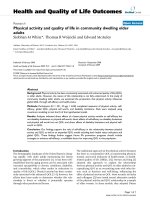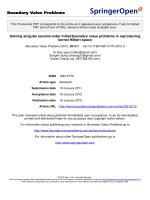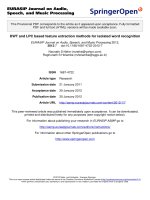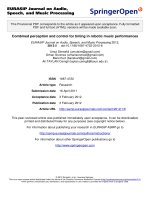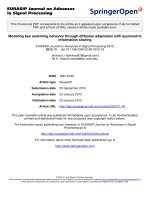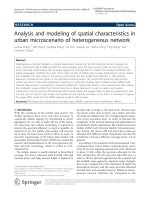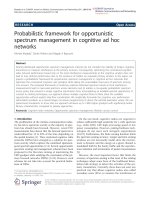Báo cáo toán học: " Solving singular second-order initial/boundary value problems in reproducing kernel Hilbert space" pptx
Bạn đang xem bản rút gọn của tài liệu. Xem và tải ngay bản đầy đủ của tài liệu tại đây (341.13 KB, 24 trang )
This Provisional PDF corresponds to the article as it appeared upon acceptance. Fully formatted
PDF and full text (HTML) versions will be made available soon.
Solving singular second-order initial/boundary value problems in reproducing
kernel Hilbert space
Boundary Value Problems 2012, 2012:3 doi:10.1186/1687-2770-2012-3
Er Gao ()
Songhe Song ()
Xinjian Zhang ()
ISSN 1687-2770
Article type Research
Submission date 13 January 2011
Acceptance date 16 January 2012
Publication date 16 January 2012
Article URL />This peer-reviewed article was published immediately upon acceptance. It can be downloaded,
printed and distributed freely for any purposes (see copyright notice below).
For information about publishing your research in Boundary Value Problems go to
/>For information about other SpringerOpen publications go to
Boundary Value Problems
© 2012 Gao et al. ; licensee Springer.
This is an open access article distributed under the terms of the Creative Commons Attribution License ( />which permits unrestricted use, distribution, and reproduction in any medium, provided the original work is properly cited.
Solving singular second-order
initial/boundary value problems in
reproducing kernel Hilbert space
Er Gao*, Songhe Song** and Xinjian Zhang***
Department of Mathematics and Systems Science, College of Science,
National University of Defense Technology, Changsha 410073, China
∗
Corresponding author:
∗∗
E-mail:
∗∗∗
E-mail: xjz
Abstract
In this paper, we presents a reproducing kernel method for computing sin-
gular second-order initial/boundary value problems (IBVPs). This method
could deal with much more general IBVPs than the ones could do, which
are given by the previous researchers. According to our work, in the first
step, the analytical solution of IBVPs is represented in the RKHS which we
constructs. Then, the analytic approximation is exhibited in this RKHS.
Finally, the 𝑛-term approximation is proved to converge to the analytical so-
lution. Some numerical examples are displayed to demonstrate the validity
and applicability of the present method. The results obtained by using the
method indicate the method is simple and effective.
Mathematics Subject Classification (2000) 35A24, 46E20, 47B32.
Preprint submitted to Boundary Value Problems December 7, 2011
1. Introduction
Initial and boundary value problems of ordinary differential equations
play an important role in many fields. Various applications of boundary to
physical, biological, chemical, and other branches of applied mathematics
are well documented in the literature. The main idea of this paper is to
present a new algorithm for computing the solutions of singular second-order
initial/boundary value problems (IBVPs) of the form:
𝑝(𝑥)𝑢
′′
(𝑥) + 𝑞(𝑥)𝑢
′
(𝑥) + 𝑟(𝑥)𝑢(𝑥) = 𝐹 (𝑥, 𝑢),
𝑎
1
𝑢(0) + 𝑏
1
𝑢
′
(0) + 𝑐
1
𝑢(1) = 0,
𝑎
2
𝑢(1) + 𝑏
2
𝑢
′
(1) + 𝑐
2
𝑢
′
(0) = 0,
(1.1)
where 𝑢(𝑥) ∈ 𝑊
3
2
[0, 1], for 𝑥 ∈ [0, 1], 𝑝 ∕= 0, 𝑝(𝑥), 𝑞(𝑥), 𝑟(𝑥) ∈ C[0, 1].
𝑎
1
, 𝑏
1
, 𝑐
1
, 𝑎
2
, 𝑏
2
, 𝑐
2
are real constants and satisfy that 𝑎
1
𝑢(0) + 𝑏
1
𝑢
′
(0) + 𝑐
1
𝑢(1)
and 𝑎
2
𝑢(1) + 𝑏
2
𝑢
′
(1) + 𝑐
2
𝑢
′
(0) are linear independent. 𝐹 (𝑥, 𝑢) is continuous.
Remark 1.1. We find that if
𝑏
1
= 𝑐
1
= 𝑏
2
= 𝑐
2
= 0, 𝑎
1
∕= 0, 𝑎
2
∕= 0, (1.2)
the problems are two-point BVPs; if
𝑏
1
= 𝑐
1
= 𝑎
2
= 𝑏
2
= 0, 𝑎
1
∕= 0, 𝑐
2
∕= 0, (1.3)
the problems are initial value problems; if
𝑏
1
= 𝑎
2
= 0, 𝑎
1
= 𝑐
1
∕= 0, 𝑏
2
= 𝑐
2
∕= 0, (1.4)
the problems are periodic BVPs; if
𝑏
1
= 𝑎
2
= 0, 𝑎
1
= −𝑐
1
∕= 0, 𝑏
2
= −𝑐
2
∕= 0, (1.5)
the problems are anti-periodic BVPs.
2
Such problems have been investigated in many researches. Specially, the
existence and uniqueness of the solution of (1.1) have been discussed in [1–5].
And in recent years, there are also a large number of special-purpose methods
are proposed to provide accurate numerical solutions of the special form of
(1.1), such as collocation methods [6], finite-element methods [7], Galerkin-
wavelet methods [8], variational iteration method [9], spectral methods [10],
finite difference methods [11], etc.
On the other hands, reproducing kernel theory has important applica-
tions in numerical analysis, differential equation, probability and statistics,
machine learning and precessing image. Recently, using the reproducing ker-
nel method, Cui and Geng [12, 13, 14, 15, 16] have make much effort to solve
some special boundary value problems.
According to our method, which is presented in this paper, some repro-
ducing kernel Hilbert spaces have been presented in the first step. And in the
second step, the homogeneous IBVPs is deal with in the RKHS. Finally, one
analytic approximation of the solutions of the second-order BVPs is given by
reproducing kernel method under the assumption that the solution to (1.1)
is unique.
2. Some RKHS
In this section, we will introduce the RKHS 𝑊
1
2
[0, 1] and 𝑊
3
2
[0, 1]. Then
we will construct a RKHS 𝐻
3
2
[0, 1], in which every function satisfies the
boundary condition of (1.1).
2.1. The RKHS 𝑊
1
2
[0, 1]
Inner space 𝑊
1
2
[0, 1] is defined as 𝑊
1
2
[0, 1] = {𝑢(𝑥)∣𝑢 is absolutely contin-
3
uous real valued functions, 𝑢
′
∈ 𝐿
2
[0, 1]}. The inner product in 𝑊
1
2
[0, 1] is
given by
(𝑓, ℎ)
𝑊
1
2
= 𝑓(0)ℎ(0) +
1
0
𝑓
′
(𝑡)ℎ
′
(𝑡) d𝑡, 𝑓, ℎ ∈ 𝑊
1
2
[0, 1] (2.1)
and the norm∥𝑢∥
𝑊
1
2
is denoted by ∥𝑢∥
𝑊
1
2
=
(𝑢, 𝑢)
𝑊
1
2
. From [17][18],
𝑊
1
2
[0, 1] is a reproducing kernel Hilbert space and the reproducing kernel
is
𝐾
1
(𝑡, 𝑠) = 1 + min{𝑡, 𝑠} (2.2)
2.2. The RKHS 𝑊
3
2
[0, 1]
Inner space 𝑊
3
2
[0, 1] is defined as 𝑊
3
2
[0, 1] = {𝑢(𝑥)∣𝑢, 𝑢
′
, 𝑢
′′
is absolutely
continuous real valued functions, 𝑢
′′′
∈ 𝐿
2
[0, 1]}.
From [15, 17, 18, 19], it is clear that 𝑊
3
2
[0, 1] become a reproducing kernel
Hilbert space if we endow it with suitable inner product.
Zhang and Lu [18] and Long and Zhang [19] give us a clue to relate the
inner product with the boundary conditions (1.1). Set 𝐿 = 𝐷
3
, and
𝛾
1
𝑓 = 𝑎
1
𝑓(0) + 𝑏
1
𝑓
′
(0) + 𝑐
1
𝑓(1),
𝛾
2
𝑓 = 𝑎
2
𝑓(1) + 𝑏
2
𝑓
′
(1) + 𝑐
2
𝑓
′
(0),
𝛾
3
𝑓 = 𝑎
3
𝑓(0) + 𝑏
3
𝑓
′
(0) + 𝑐
3
𝑓
′′
(0),
(2.3)
where 𝑎
3
, 𝑏
3
, 𝑐
3
is random but satisfying that 𝛾
3
is linearly independent of 𝛾
1
and 𝛾
2
.
It is easy to know that 𝛾
1
, 𝛾
2
, 𝛾
3
are linearly independent in 𝐾𝑒𝑟𝐿. Then
from [18, 19], it is easy to know one of the inner products of 𝑊
3
2
[0, 1]
(𝑓, ℎ)
𝑊
3
2
=
3
𝑖=1
𝛾
𝑖
𝑓𝛾
𝑖
ℎ +
1
0
𝑓
′′′
(𝑡)ℎ
′′′
(𝑡) d𝑡, 𝑓, ℎ ∈ 𝑊
3
2
[0, 1] (2.4)
4
and its corresponding reproducing kernel 𝐾
2
(𝑡, 𝑠).
2.3. The RKHS 𝐻
3
2
[0, 1]
Inner space 𝐻
3
2
[0, 1] is defined as 𝐻
3
2
[0, 1] = {𝑢(𝑥)∣𝑢, 𝑢
′
, 𝑢
′′
are absolutely
continuous real valued functions, 𝑢
′′′
∈ 𝐿
2
[0, 1], and 𝑎
1
𝑢(0)+𝑏
1
𝑢
′
(0)+𝑐
1
𝑢(1) =
0, 𝑎
2
𝑢(1) + 𝑏
2
𝑢
′
(1) + 𝑐
2
𝑢
′
(0) = 0}.
It is clear that 𝐻
3
2
[0, 1] is the complete subspace of 𝑊
3
2
[0, 1], so 𝐻
3
2
[0, 1] is
a RKHS. If 𝑃 , which is the orthogonal projection from 𝑊
3
2
[0, 1] to 𝐻
3
2
[0, 1],
is found, we can get the reproducing kernel of 𝐻
3
2
[0, 1] obviously. Under the
assumptions of Section 2, note
𝑃 𝑓(𝑡) = (𝛾
3
𝑓)𝑒
3
(𝑡) +
1
0
𝐺(𝑡, 𝜏) ⋅ 𝑓
′′′
(𝜏) d𝜏, ∀𝑓 ∈ 𝑊
3
2
[0, 1] (2.5)
Theorem 2.1. Under the assumptions above, 𝑃 is the orthogonal projection
from 𝑊
3
2
[𝑎, 𝑏] to 𝐻
3
2
[0, 1].
Proof. For all 𝑓 ∈ 𝑊
3
2
[0, 1], We have
(𝛾
1
(𝑃 𝑓))(𝑡) = (𝛾
2
(𝑃 𝑓))(𝑡) = 0
That means 𝑃 𝑓 ∈ 𝐻
3
2
[0, 1]. At the same time, for any 𝑓, ℎ ∈ 𝑊
3
2
[0, 1]
(𝑃 𝑓, ℎ) =
(𝛾
3
𝑓)𝑒
3
(𝑡) +
1
0
𝐺(𝑡, 𝜏) ⋅ 𝐿𝑓 (𝜏) d𝜏, ℎ
= (𝛾
3
𝑓)(𝛾
3
ℎ) +
1
0
𝐿
1
0
𝐺(𝑡, 𝜏) ⋅ 𝐿𝑓 (𝜏) 𝑑𝜏
⋅ 𝐿ℎ(𝑡) d𝑡
= (𝛾
3
𝑓)(𝛾
3
ℎ) +
1
0
𝐿𝑓(𝑡) ⋅ 𝐿ℎ(𝑡) d𝑡
5
(𝑓, 𝑃ℎ) =
𝑓, (𝛾
3
ℎ)𝑒
3
(𝑡) +
1
0
𝐺(𝑡, 𝜏) ⋅ 𝐿ℎ(𝜏 ) d𝜏
= (𝛾
3
𝑓)(𝛾
3
ℎ) +
1
0
𝐿𝑓(𝑡) ⋅ 𝐿
1
0
𝐺(𝑡, 𝜏) ⋅ 𝐿ℎ(𝜏 ) d𝜏 d𝑡
= (𝛾
3
𝑓)(𝛾
3
ℎ) +
1
0
𝐿𝑓(𝑡) ⋅ 𝐿ℎ(𝑡) d𝑡
𝑃 is self-conjugate. And
𝑃 (𝑃 𝑓 ) = 𝑃
(𝛾
3
𝑓)𝑒
3
(𝑡) +
1
0
𝐺(𝑡, 𝜏) ⋅ 𝐿𝑓 (𝜏) d𝜏
= (𝛾
3
𝑓)𝑒
3
(𝑡) +
1
0
𝐺(𝑡, 𝜏) ⋅ 𝐿
(𝛾
3
𝑓)𝑒
3
(𝜏) +
1
0
𝐺(𝜏, 𝑠) ⋅ 𝐿𝑓(𝑠) d𝑠
, d𝜏
= (𝛾
3
𝑓)𝑒
3
(𝑡) +
1
0
𝐺(𝑡, 𝜏) ⋅ 𝐿𝑓 (𝜏) d𝜏
= 𝑃 𝑓
𝑃 is idempotent.
So 𝑃 is the orthogonal projection from 𝑊
3
2
[0, 1] to 𝐻
3
2
[0, 1].
The proof of the Theorem 2.1 is complete.
Now, 𝐻
3
2
[0, 1] is a RKHS if endowed the inner product with the inner
product below
(𝑓, ℎ)
𝐻
3
2
= 𝛾
3
𝑓𝛾
3
ℎ +
1
0
𝑓
′′′
(𝑡) ⋅ ℎ
′′′
(𝑡) d𝑡 (2.6)
and the corresponding reproducing kernel 𝐾
3
(𝑡, 𝑠) is given in Appendix 4.
6
3. The reproducing kernel method
In this section, the representation of analytical solution of (1.1) is given
in the reproducing kernel space 𝐻
3
2
[0, 1].
Note 𝐿𝑢 = 𝑝(𝑥)𝑢
′′
(𝑥) + 𝑞(𝑥)𝑢
′
(𝑥) + 𝑟(𝑥)𝑢(𝑥) in (1.1). It is clear that
𝐿 : 𝐻
3
2
[0, 1] → 𝑊
1
2
[0, 1] is a bounded linear operator.
Put 𝜑
𝑖
(𝑥) = 𝐾
1
(𝑥
𝑖
, 𝑥), Ψ
𝑖
(𝑥) = 𝐿
∗
𝜑
𝑖
(𝑥), where 𝐿
∗
is the adjoint operator
of 𝐿. Then
Ψ
𝑖
(𝑥) = (𝐿
∗
𝜑
𝑖
(𝑦), 𝐾
3
(𝑥, 𝑦))
= (𝜑
𝑖
(𝑦), 𝐿
𝑦
𝐾
3
(𝑥, 𝑦))
= (𝐿
𝑦
𝐾
3
(𝑥, 𝑦), 𝜑
𝑖
(𝑥)) = 𝐿
𝑦
𝐾
3
(𝑥, 𝑦) ∣
𝑦=𝑥
𝑖
(3.1)
Lemma 3.1. Under the assumptions above, if {𝑥
𝑖
}
∞
𝑖=1
is dense on [0, 1] then
{Ψ
𝑖
(𝑥)}
∞
𝑖=1
is the complete basis of 𝐻
3
2
[0, 1].
The orthogonal system {Ψ
𝑖
(𝑥)}
∞
𝑖=1
of 𝐻
3
2
[0, 1] can be derived from Gram–
Schmidt orthogonalization process of {Ψ
𝑖
(𝑥)}
∞
𝑖=1
, and
Ψ
𝑖
(𝑥) =
𝑖
𝑗=1
𝛽
𝑖𝑗
Ψ
𝑗
(𝑥).
Then
Theorem 3.1. If {𝑥
𝑖
}
∞
𝑖=1
is dense on [0, 1] and the solution of (1.1) is unique,
the solution can be expressed in the form
𝑢(𝑥) =
∞
𝑖=1
𝑖
𝑘=1
𝛽
𝑖𝑘
𝐹 (𝑥
𝑘
, 𝑢(𝑥
𝑘
))Ψ
𝑖
(𝑥) (3.2)
7
Proof. From Lemma 3.1, {Ψ
𝑖
(𝑥)}
∞
𝑖=1
is the complete system of 𝐻
3
2
[0, 1]. Hence
we have
𝑢(𝑥) =
∞
𝑖=1
(𝑢(𝑥), Ψ
𝑖
(𝑥))Ψ
𝑖
(𝑥) =
∞
𝑖=1
𝑖
𝑘=1
𝛽
𝑖𝑘
(𝑢(𝑥), Ψ
𝑖
(𝑥))Ψ
𝑖
(𝑥)
=
∞
𝑖=1
𝑖
𝑘=1
𝛽
𝑖𝑘
(𝑢(𝑥), 𝐿
∗
𝜑
𝑘
(𝑥))Ψ
𝑖
(𝑥) =
∞
𝑖=1
𝑖
𝑘=1
𝛽
𝑖𝑘
(𝐿𝑢(𝑥), 𝜑
𝑘
(𝑥))Ψ
𝑖
(𝑥)
=
∞
𝑖=1
𝑖
𝑘=1
𝛽
𝑖𝑘
(𝐹 (𝑥, 𝑢(𝑥)), 𝜑
𝑘
(𝑥))Ψ
𝑖
(𝑥) =
∞
𝑖=1
𝑖
𝑘=1
𝛽
𝑖𝑘
𝐹 (𝑥
𝑘
, 𝑢(𝑥
𝑘
))Ψ
𝑖
(𝑥)
and the proof is complete.
The approximate solution of the (1.1) is
𝑢
𝑛
(𝑥) =
𝑛
𝑖=1
𝑖
𝑘=1
𝛽
𝑖𝑘
𝐹 (𝑥
𝑘
, 𝑢(𝑥
𝑘
))Ψ
𝑖
(𝑥) (3.3)
If (1.1) is linear, that is 𝐹 (𝑥, 𝑢(𝑥)) = 𝐹 (𝑥), then the approximate solution
of (1.1) can be obtained directly from (3.3). Else, the approximate process
could be modified into the following form:
𝑢
0
(𝑥) = 0
𝑢
𝑛+1
(𝑥) =
𝑛+1
𝑖=1
𝐵
𝑖
Ψ
𝑖
(𝑥)
(3.4)
where 𝐵
𝑖
=
𝑖
𝑘=1
𝛽
𝑖𝑘
𝐹 (𝑥
𝑘
, 𝑢
𝑛
(𝑥
𝑘
)).
Next, the convergence of 𝑢
𝑛
(𝑥) will be proved.
Lemma 3.2. There exists a constant 𝑀 , satisfied ∣𝑢(𝑥)∣ ≤ 𝑀∥𝑢∥
𝐻
3
2
, for all
𝑢(𝑥) ∈ 𝐻
3
2
[0, 1].
Proof. For all 𝑥 ∈ [0, 1] and 𝑢 ∈ 𝐻
3
2
[0, 1], there are
∣𝑢(𝑥)∣ = ∣(𝑢(⋅), 𝐾
3
(⋅, 𝑥))∣ ≤ ∥𝐾
3
(⋅, 𝑥)∥
𝐻
3
2
⋅ ∥𝑢∥
𝐻
3
2
.
8
Since 𝐾
3
(⋅, 𝑥) ∈ 𝐻
3
2
[0, 1], note
𝑀 = max
𝑥∈[0,1]
∥𝐾
3
(⋅, 𝑥)∥
𝐻
3
2
.
That is, ∣𝑢(𝑥)∣ ≤ 𝑀∥𝑢∥
𝐻
3
2
.
By Lemma 3.2, it is easy to obtain the following lemma.
Lemma 3.3. If 𝑢
𝑛
∥⋅∥
−→ ¯𝑢(𝑛 → ∞), ∥𝑢
𝑛
∥ is bounded, 𝑥
𝑛
→ 𝑦(𝑛 → ∞) and
𝐹 (𝑥, 𝑢(𝑥)) is continuous, then 𝐹 (𝑥
𝑛
, 𝑢
𝑛−1
(𝑥
𝑛
)) → 𝐹 (𝑦, ¯𝑢(𝑦)).
Theorem 3.2. Suppose that ∥𝑢
𝑛
∥ is bounded in (3.3) and (1.1) has a unique
solution. If {𝑥
𝑖
}
∞
𝑖=1
is dense on [0, 1], then the 𝑛-term approximate solution
𝑢
𝑛
(𝑥) derived from the above method converges to the analytical solution 𝑢(𝑥)
of (1.1).
Proof. First, we will prove the convergence of 𝑢
𝑛
(𝑥).
From (3.4), we infer that
𝑢
𝑛+1
(𝑥) = 𝑢
𝑛
(𝑥) + 𝐵
𝑛+1
Ψ
𝑛+1
(𝑥).
The orthonormality of {Ψ
𝑖
}
∞
𝑖=1
yield that
∥𝑢
𝑛+1
∥
2
= ∥𝑢
𝑛
∥
2
+ (𝐵
𝑛+1
)
2
= ⋅ ⋅ ⋅ =
𝑛+1
𝑖=1
(𝐵
𝑖
)
2
.
That means ∥𝑢
𝑛+1
∥ ≥ ∥𝑢
𝑛
∥. Due to the condition that ∥𝑢
𝑛
∥ is bounded,
∥𝑢
𝑛
∥ is convergent and there exists a constant ℓ such that
∞
𝑖=1
(𝐵
𝑖
)
2
= ℓ.
If 𝑚 > 𝑛, then
∥𝑢
𝑚
− 𝑢
𝑛
∥
2
= ∥𝑢
𝑚
− 𝑢
𝑚−1
+ 𝑢
𝑚−1
− 𝑢
𝑚−2
+ ⋅ ⋅ ⋅ + 𝑢
𝑛+1
− 𝑢
𝑛
∥
2
.
9
In view of (𝑢
𝑚
− 𝑢
𝑚−1
) ⊥ (𝑢
𝑚−1
− 𝑢
𝑚−2
) ⊥ ⋅ ⋅ ⋅ ⊥ (𝑢
𝑛+1
− 𝑢
𝑛
), it follows that
∥𝑢
𝑚
− 𝑢
𝑛
∥
2
= ∥𝑢
𝑚
− 𝑢
𝑚−1
∥
2
+ ∥𝑢
𝑚−1
− 𝑢
𝑚−2
∥
2
+ ⋅ ⋅ ⋅ + ∥𝑢
𝑛+1
− 𝑢
𝑛
∥
2
=
𝑚
𝑖=𝑛+1
(𝐵
𝑖
)
2
→ 0 as 𝑛 → ∞
The completeness of 𝐻
3
2
[0, 1] shows that 𝑢
𝑛
→ ¯𝑢 as 𝑛 → ∞ in the sense of
∥ ⋅ ∥
𝐻
3
2
.
Secondly, we will prove that ¯𝑢 is the solution of (1.1).
Taking limits in (3.2), we get
¯𝑢(𝑥) =
∞
𝑖=1
𝐵
𝑖
Ψ
𝑖
(𝑥).
So
𝐿¯𝑢(𝑥) =
∞
𝑖=1
𝐵
𝑖
𝐿Ψ
𝑖
(𝑥)
and
(𝐿¯𝑢)(𝑥) =
∞
𝑖=1
𝐵
𝑖
(𝐿Ψ
𝑖
, 𝜑
𝑛
) =
∞
𝑖=1
𝐵
𝑖
(Ψ
𝑖
, 𝐿
∗
𝜑
𝑛
) =
∞
𝑖=1
𝐵
𝑖
(Ψ
𝑖
, Ψ
𝑛
). (3.5)
Therefore,
𝑛
𝑖=1
𝛽
𝑛𝑗
(𝐿¯𝑣)(𝑥
𝑛
) =
∞
𝑖=1
𝐵
𝑖
Ψ
𝑖
,
𝑛
𝑖=1
𝛽
𝑛𝑗
Ψ
𝑗
=
∞
𝑖=1
𝐵
𝑖
(Ψ
𝑖
, Ψ
𝑛
) = 𝐵
𝑛
.
If 𝑛 = 1, then
𝐿¯𝑢(𝑥
1
) = 𝐹 (𝑥
1
, 𝑢
0
(𝑥
1
)).
If 𝑛 = 2, then
𝛽
21
𝐿¯𝑢(𝑥
1
) + 𝛽
22
𝐿¯𝑢(𝑥
2
) = 𝛽
21
𝐹 (𝑥
1
, 𝑢
0
(𝑥
1
)) + 𝛽
22
𝐹 (𝑥
2
, 𝑢
1
(𝑥
2
)).
It is clear that
(𝐿¯𝑢)(𝑥
2
) = 𝐹 (𝑥
2
, 𝑢
1
(𝑥
2
)).
10
Moreover, it is easy to see by induction that
(𝐿¯𝑢)(𝑥
𝑗
) = 𝐹 (𝑥
𝑗
, 𝑢
𝑗−1
(𝑥
𝑗
)), 𝑗 = 1, 2, . . . (3.6)
Since {𝑥
𝑖
}
∞
𝑖=1
is dense on [0, 1], for all 𝑌 ∈ [0, 1], there exists a subsequence
{𝑥
𝑛𝑗
}
∞
𝑗=1
such that
𝑥
𝑛𝑗
→ 𝑌 as 𝑗 → ∞. (3.7)
It is easy to see that (𝐿¯𝑢)(𝑥
𝑛𝑗
) = 𝐹 (𝑥
𝑛𝑗
, 𝑢
𝑛𝑗−1
(𝑥
𝑛𝑗
)). Let 𝑗 → ∞, by the
continuity of 𝐹 (𝑥, 𝑢(𝑥)) and Lemma 3.3, we have
(𝐿¯𝑢)(𝑌 ) = 𝐹 (𝑌, ¯𝑢(𝑌 )). (3.8)
At the same time, ¯𝑢 ∈ 𝐻
3
2
[0, 1]. Clearly, 𝑢 satisfies the boundary conditions
of (1.1).
That is, ¯𝑢 is the solution of (1.1).
The proof is complete.
In fact, 𝑢
𝑛
(𝑥) is just the orthogonal projection of exact solution ¯𝑢(𝑥) onto
the space Span{Ψ
𝑖
}
𝑛
𝑖=1
.
4. Numerical example
In this section, some examples are studied to demonstrate the validity
and applicability of the present method. We compute them and compare the
results with the exact solution of each example.
Example 4.1. Consider the following IBVPs:
𝑥
2
(1 − 𝑥)𝑢
′′
(𝑥) + 2𝑢
′
(𝑥) + 10𝑥𝑢(𝑥) + 𝑥
2
(1 − 𝑥)(𝑢(𝑥) + 1)
2
= 𝑓(𝑥), 0 < 𝑥 < 1,
𝑢(0) + 𝑢
′
(0) + 𝑢(1) = 0,
𝑢(1) + 𝑢
′
(1) + 𝑢
′
(0) = 0,
11
where 𝑓(𝑥) = 10𝑥𝑒
10(𝑥−𝑥
2
)
2
+ 40𝑒
10(𝑥−𝑥
2
)
2
(1−2𝑥)(𝑥−𝑥
2
)
+ 𝑥
2
(1 − 𝑥)(𝑒
20(𝑥−𝑥
2
)
2
+
20𝑒
10(𝑥−𝑥
2
)
2
(1 − 2𝑥)
2
− 40𝑒
10(𝑥−𝑥
2
)
2
(𝑥 − 𝑥
2
) + 400𝑒
10(𝑥−𝑥
2
)
2
(1 − 2𝑥)
2
(𝑥 − 𝑥
2
)
2
).
The exact solution is 𝑢(𝑥) = 𝑒
10(𝑥−𝑥
2
)
2
− 1. Using our method, take 𝑎
3
=
1, 𝑏
3
= 𝑐
3
= 0 and 𝑛 = 21, 51, 𝑁 = 5, 𝑥
𝑖
=
𝑖−1
𝑛−1
. The numerical results are
given in Tables 1 and 2.
Example 4.2. Consider the following IBVPs:
𝑢
′′
(𝑥) + 𝑢
′
(𝑥) + 𝑥(1 − 𝑥)(𝑢(𝑥) − 1)
3
= 𝑓(𝑥), 0 ≤ 𝑥 ≤ 1,
−
𝜋
2
𝑢(0) + 𝑢
′
(0) −
𝜋
2
𝑢(1) = 0,
𝜋𝑢(1) + 2𝑢
′
(1) + 3𝑢
′
(0) = 0,
where 𝑓(𝑥) = 𝜋 cos(𝜋𝑥) − sin(𝜋𝑥)(𝜋
2
+ (−1 + 𝑥) ∗ 𝑥 ∗ sin
2
(𝜋 ∗ 𝑥)). The true
solution is 𝑢(𝑥) = sin(𝜋𝑥) + 1. Using our method, take 𝑎
3
= 1, 𝑏
3
= 𝑐
3
= 0,
and 𝑁 = 5, 𝑛 = 21, 51, 𝑥
𝑖
=
𝑖−1
𝑛−1
. The numerical results are given in Figures
1, 2, 3 and 4.
Contributions
Er Gao gives the main idea and proves the most of the theorems and
propositions in the paper. He also takes part in the work of numerical exper-
iment of the main results. Xinjian Zhang suggests some ideas for the prove
of the main theorems. Songhe Song mainly accomplishes most part of the
numerical experiments. All authors read and approved the final manuscript.
Competing interests
The authors declare that they have no competing interests.
12
Acknowledgements
The work is supported by NSF of China under Grant Numbers 10971226.
Appendix A: The reproducing kernel of 𝑯
3
2
[0, 1]
The reproducing kernel of 𝐻
3
2
[0, 1] is
𝐾
3
[𝑡, 𝑠] =
Λ
1
120Δ
+
Λ
2
Δ
2
+
Λ
3
120Δ
+
Λ
4
40Δ
2
+
Λ
5
120Δ
+
Λ
6
120Δ
+
Λ
7
120Δ
2
+
1
120
(𝑠
5
− 5𝑠
4
𝑡 + 10𝑠
3
𝑡
2
), 𝑡 ≥ 𝑠,
1
120
(𝑡
5
− 5𝑡
4
𝑠 + 10𝑡
3
𝑠
2
), 𝑡 < 𝑠,
13
where
Δ = 𝑎
3
(2𝑏
1
𝑏
2
+ 𝑏
2
𝑐
1
− 𝑐
1
𝑐
2
) + 𝑎
2
(𝑎
3
𝑏
1
− 𝑎
1
𝑏
3
+ 2𝑎
1
𝑐
3
− 2𝑏
1
𝑐
3
)
− 2(𝑎
1
+ 𝑐
1
)(𝑏
2
𝑏
3
− 𝑏
2
𝑐
3
− 𝑐
2
𝑐
3
),
Λ
1
= (𝑐
1
(−2𝑐
2
𝑐
3
+ 𝑎
3
𝑐
2
𝑠
2
− 𝑎
2
(−1 + 𝑠)(𝑏
3
− 2𝑐
3
− 𝑎
3
𝑠 + 𝑏
3
𝑠)
+ 𝑏
2
(2𝑏
3
− 2𝑐
3
+ 𝑎
3
(−2 + 𝑠)𝑠))𝑡
3
(10 − 5𝑡 + 𝑡
2
)),
Λ
2
= (2𝑏
1
𝑏
2
+ 𝑏
2
𝑐
1
− 𝑐
1
𝑐
2
− 2𝑎
1
𝑏
2
𝑠 − 2𝑏
2
𝑐
1
𝑠 + 𝑎
1
𝑏
2
𝑠
2
+ 𝑏
2
𝑐
1
𝑠
2
+ 𝑎
1
𝑐
2
𝑠
2
+ 𝑐
1
𝑐
2
𝑠
2
− 𝑎
2
(−1 + 𝑠)(𝑏
1
− 𝑎
1
𝑠 + 𝑏
1
𝑠))
× (2𝑏
1
𝑏
2
+ 𝑏
2
𝑐
1
− 𝑐
1
𝑐
2
− 2𝑎
1
𝑏
2
𝑡 − 2𝑏
2
𝑐
1
𝑡 + 𝑎
1
𝑏
2
𝑡
2
+ 𝑏
2
𝑐
1
𝑡
2
+ 𝑎
1
𝑐
2
𝑡
2
+ 𝑐
1
𝑐
2
𝑡
2
− 𝑎
2
(−1 + 𝑡)(𝑏
1
− 𝑎
1
𝑡 + 𝑏
1
𝑡)),
Λ
3
= 𝑐
1
𝑠
3
(10 − 5𝑠 + 𝑠
2
)(−𝑎
2
(−1 + 𝑡)(𝑏
3
− 2𝑐
3
− 𝑎
3
𝑡 + 𝑏
3
𝑡)
− 2𝑐
2
𝑐
3
+ 𝑎
3
𝑐
2
𝑡
2
+ 𝑏
2
(2𝑏
3
− 2𝑐
3
+ 𝑎
3
(−2 + 𝑡)𝑡),
Λ
4
= 𝑐
1
(2(𝑐
1
𝑐
2
(−2𝑐
3
+ 𝑎
3
𝑠
2
) + 𝑎
2
(2𝑏
1
𝑐
3
− 2𝑎
1
𝑐
3
𝑠 − 𝑎
3
𝑏
1
𝑠
2
+ 𝑎
1
𝑏
3
𝑠
2
))
+ 𝑏
2
(10𝑏
1
𝑐
3
+ 6𝑐
1
𝑐
3
+ 𝑎
3
𝑐
1
𝑠 − 10𝑎
1
𝑐
3
𝑠 − 10𝑐
1
𝑐
3
𝑠 − 5𝑎
3
𝑏
1
𝑠
2
− 3𝑎
3
𝑐
1
𝑠
2
+ 𝑏
3
(−𝑐
1
+ 5𝑎
1
𝑠
2
+ 5𝑐
1
𝑠
2
)))(−2𝑐
2
𝑐
3
+ 𝑎
3
𝑐
2
𝑡
2
− 𝑎
2
(−1 + 𝑡)(𝑏
3
− 2𝑐
3
− 𝑎
3
𝑡 + 𝑏
3
𝑡) + 𝑏
2
(2𝑏
3
− 2𝑐
3
+ 𝑎
3
(−2 + 𝑡)𝑡)),
Λ
5
= (2𝑏
1
𝑐
3
+ 2𝑐
1
𝑐
3
+ 𝑎
3
𝑐
1
𝑠 − 2𝑎
1
𝑐
3
𝑠 − 2𝑐
1
𝑐
3
𝑠 − 𝑎
3
𝑏
1
𝑠
2
− 𝑎
3
𝑐
1
𝑠
2
+ 𝑏
3
(𝑎
1
𝑠
2
+ 𝑐
1
(−1 + 𝑠
2
)))𝑡
3
(−5𝑏
2
(−4 + 𝑡) + 𝑎
2
(10 − 5𝑡 + 𝑡
2
)),
Λ
6
= 𝑠
3
(−5𝑏
2
(−4 + 𝑠) + 𝑎
2
(10 − 5𝑠 + 𝑠
2
))(2𝑏
1
𝑐
3
+ 2𝑐
1
𝑐
3
+ 𝑎
3
𝑐
1
𝑡
− 2𝑎
1
𝑐
3
𝑡 − 2𝑐
1
𝑐
3
𝑡 − 𝑎
3
𝑏
1
𝑡
2
− 𝑎
3
𝑐
1
𝑡
2
+ 𝑏
3
(𝑎
1
𝑡
2
+ 𝑐
1
(−1 + 𝑡
2
))),
14
Λ
7
= (6𝑎
2
2
(𝑎
1
𝑠(−2𝑐
3
+ 𝑏
3
𝑠) + 𝑏
1
(2𝑐
3
− 𝑎
3
𝑠
2
)) + 3𝑎
2
(2𝑐
1
𝑐
2
(−2𝑐
3
+ 𝑎
3
𝑠
2
)
+ 𝑏
2
(−𝑏
3
𝑐
1
+ 20𝑏
1
𝑐
3
+ 6𝑐
1
𝑐
3
+ 𝑎
3
𝑐
1
𝑠 − 20𝑎
1
𝑐
3
𝑠 − 10𝑐
1
𝑐
3
𝑠 − 10𝑎
3
𝑏
1
𝑠
2
+ 10𝑎
1
𝑏
3
𝑠
2
− 3𝑎
3
𝑐
1
𝑠
2
+ 5𝑏
3
𝑐
1
𝑠
2
)) + 5𝑏
2
(3𝑐
1
𝑐
2
(−2𝑐
3
+ 𝑎
3
𝑠
2
)
+ 𝑏
2
(−2𝑏
3
𝑐
1
+ 16𝑏
1
𝑐
3
+ 10𝑐
1
𝑐
3
+ 2𝑎
3
𝑐
1
𝑠 − 16𝑎
1
𝑐
3
𝑠 − 16𝑐
1
𝑐
3
𝑠 − 8𝑎
3
𝑏
1
𝑠
2
+ 8𝑎
1
𝑏
3
𝑠
2
− 5𝑎
3
𝑐
1
𝑠
2
+ 8𝑏
3
𝑐
1
𝑠
2
)))(2𝑏
1
𝑐
3
+ 2𝑐
1
𝑐
3
+ 𝑎
3
𝑐
1
𝑡 − 2𝑎
1
𝑐
3
𝑡
− 2𝑐
1
𝑐
3
𝑡 − 𝑎
3
𝑏
1
𝑡
2
− 𝑎
3
𝑐
1
𝑡
2
+ 𝑏
3
(𝑎
1
𝑡
2
+ 𝑐
1
(−1 + 𝑡
2
))).
References
[1] Erbe, L.H., Wang, H Y.: On the existence of positive solutions of or-
dinary differential equations. Proc. Am. Math. Soc. 120(3), 743–748
(1994)
[2] Kaufmann, E.R., Kosmatov, N.: A second-order singular boundary
value problem. Comput. Math. Appl. 47, 1317–1326 (2004)
[3] Yang, F H.: Necessary and sufficient condition for the existence of posi-
tive solution to a class of singular second-order boundary value problems.
Chin. J. Eng. Math. 25(2), 281–287 (2008)
[4] Zhang, X G.: Positive solutions of nonresonance semipositive singular
Dirichlet boundary value problems. Nonlinear Anal. 68, 97–108 (2008)
[5] Ma, R Y., Ma, H L.: Positive solutions for nonlinear discrete periodic
boundary value problems. Comput. Math. Appl. 59, 136–141 (2010)
[6] Russell, R.D., Shampine, L.F.: A collocation method for boundary value
problems. Numer. Math. 19, 1–28 (1972)
15
[7] Stynes, M., O’Riordan, E.: A uniformly accurate finite-element method
for a singular-perturbation problem in conservative form. SIAM J. Nu-
mer. Anal. 23, 369–375 (1986)
[8] Xu, J C., Shann, W C.: Galerkin-wavelet methods for two-point
boundary value problems. Numer. Math. 63, 123–144 (1992)
[9] He, J H.: Variational iteration method—a kind of non-linear analytical
technique: some examples. Nonlinear Mech. 34, 699–708 (1999)
[10] Capizzano, S.S.: Spectral behavior of matrix sequences and discretized
boundary value problems. Linear Algebra Appl. 337, 37–78 (2001)
[11] Ilicasu, F.O., Schultz, D.H.: High-order finite-difference techniques for
linear singular perturbation boundary value problems. Comput. Math.
Appl. 47, 391–417 (2004)
[12] Cui, M G., Geng, F Z.: A computational method for solving one-
dimensional variable-coefficient Burgers equation. Appl. Math. Comput.
188, 1389–1401 (2007)
[13] Cui, M G., Chen, Z.: The exact solution of nonlinear age-structured
population model. Nonlinear Anal. Real World Appl. 8, 1096–1112
(2007)
[14] Geng, F Z.: Solving singular second order three-point boundary value
problems using reproducing kernel Hilbert space method. Appl. Math.
Comput. 215, 2095–2102 (2009)
16
[15] Geng, F Z., Cui, M G.: Solving singular nonlinear second-order peri-
odic boundary value problems in the reproducing kernel space. Appl.
Math. Comput. 192, 389–398 (2007)
[16] Jiang, W., Cui, M G., Lin, Y Z.: Anti-periodic solutions for Rayleigh-
type equations via the reproducing kernel Hilbert space method. Com-
mun. Nonlinear Sci. Numer. Simulat. 15, 1754–1758 (2010)
[17] Zhang, X J., Long, H.: Computating reproducing kernels for 𝑊
𝑚
2
[𝑎, 𝑏]
(I). Math. Numer. Sin. 30(3), 295–304 (2008) (in Chinese)
[18] Zhang, X J., Lu, S R.: Computating reproducing kernels for 𝑊
𝑚
2
[𝑎, 𝑏]
(II). Math. Numer. Sin. 30(4), 361–368 (2008) (in Chinese)
[19] Long, H., Zhang, X J.: Construction and calculation of reproducing
kernel determined by various linear differential operators. Appl. Math.
Comput. 215, 759–766 (2009)
Figures
Figure 1
The absolute error of Example 4.2 (𝑛 = 21, 𝑁 = 5).
Figure 2
The relative error of Example 4.2 (𝑛 = 21, 𝑁 = 5).
Figure 3
The absolute error of Example 4.2 (𝑛 = 51, 𝑁 = 5).
17
Figure 4
The relative error of Example 4.2 (𝑛 = 51, 𝑁 = 5).
Tables
Table 1
Numerical results for Example 4.1 (𝑛 = 21, 𝑁 = 5)
𝑥 True solution 𝑢(𝑥) Approximate solution 𝑢
11
Absolute error Relative error
0.08 0.05566 0.05530 3.6E−4 6.5E−3
0.16 0.19798 0.19765 3.3E−4 1.7E−3
0.24 0.39473 0.39443 3.0E−4 7.6E−4
0.32 0.60560 0.60526 3.4E−4 5.6E−4
0.40 0.77891 0.77839 5.2E−4 6.6E−4
0.48 0.86452 0.86385 6.7E−4 7.7E−4
0.56 0.83516 0.83457 5.9E−4 7.1E−4
0.64 0.70036 0.70009 2.7E−4 3.8E−4
0.72 0.50144 0.50146 1.8E−5 3.6E−4
0.80 0.29175 0.29175 3.2E−6 1.1E−5
0.88 0.11797 0.11771 2.6E−4 2.2E−3
0.96 0.01485 0.01453 3.3E−4 2.2E−3
Table 2
Numerical results for Example 4.1 ( 𝑛 = 51, 𝑁 = 5)
18
𝑥 True solution 𝑢(𝑥) Approximate solution 𝑢
11
Absolute error Relative error
0.08 0.05566 0.05564 2.3E−5 4.1E−4
0.16 0.19798 0.19796 2.1E−5 1.1E−4
0.24 0.39473 0.39471 2.0E−5 4.9E−5
0.32 0.60560 0.60557 2.8E−5 4.6E−5
0.40 0.77891 0.77885 5.6E−5 7.1E−5
0.48 0.86452 0.86444 8.0E−5 9.3E−5
0.56 0.83516 0.83509 6.6E−5 7.9E−5
0.64 0.70036 0.70035 9.6E−6 1.4E−5
0.72 0.50144 0.50148 4.3E−5 8.6E−5
0.80 0.29175 0.29180 4.7E−5 1.6E−5
0.88 0.11797 0.11797 2.2E−6 1.9E−5
19
0.2
0.4
0.6
0.8
1.0
0.0015
0.0020
0.0025
0.0030
Figure 1
0.2
0.4
0.6
0.8
1.0
0.0010
0.0015
0.0020
0.0025
0.0030
Figure 2
0.2
0.4
0.6
0.8
1.0
0.00030
0.00035
0.00040
0.00045
0.00050
0.00055
0.00060
Figure 3
0.2
0.4
0.6
0.8
1.0
0.0003
0.0004
0.0005
0.0006
Figure 4
